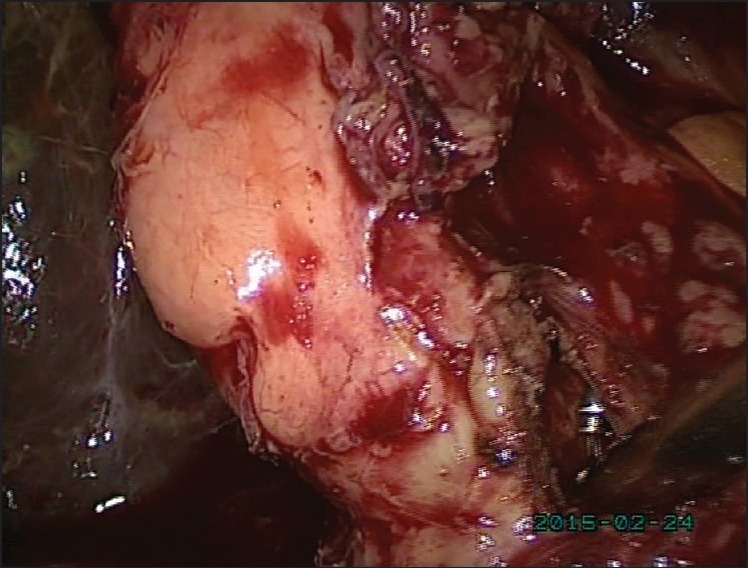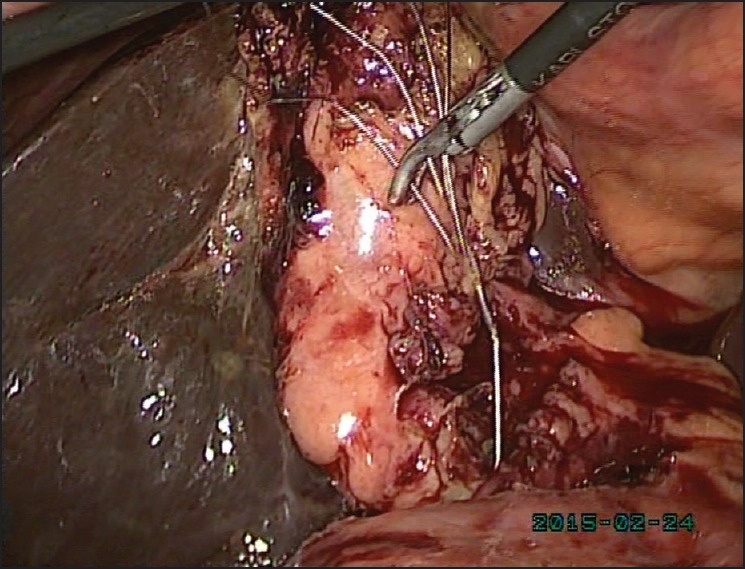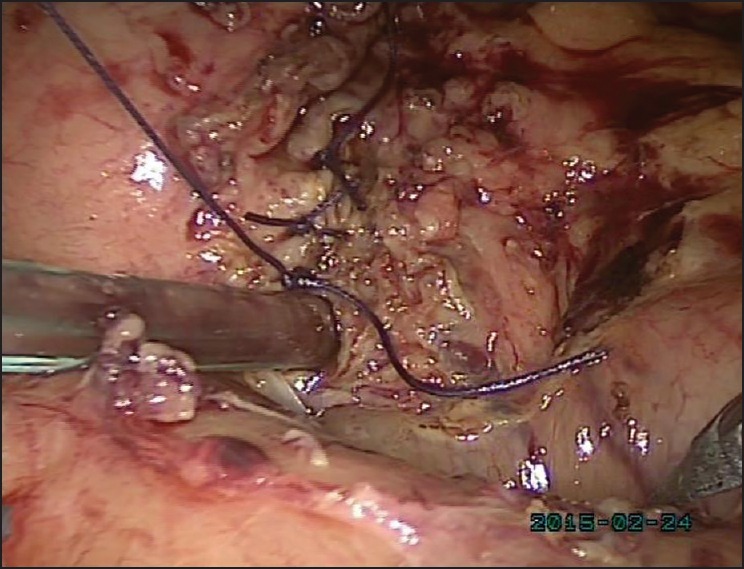Abstract
For choledocholithiasis, endoscopic management is the first line of treatment. Both Dormia basket and balloon catheter are used to retrieve common bile duct (CBD) stones. Here we present a case of impaction of the Dormia basket during an endoscopic procedure. The patient was managed through laparoscopic choledochotomy, and the basket was found to be impacted with a common bile stone of size 18 mm. The stone was disengaged from the basket and, by holding the tip of the basket, was removed through one of the laparoscopic ports.
Keywords: Basket, Dormia, impacted
INTRODUCTION
Endoscopic management of common bile duct (CBD) stones has become standard first-line therapy. Stone retrieval can be done using Dormia basket or balloon catheter in addition to mechanical lithotriptor, laser lithotripsy, extracorporeal shock wave lithotripsy, etc. Endoscopic retrograde cholangiopancreatography (ERCP) is successful in 80-90% of cases of choledocholithiasis. Complications of ERCP include pancreatitis, cholangitis and intestinal perforations. One of the rare complications of ERCP is impaction or fracture of the Dormia basket. Impaction of the Dormia basket is a rarer complication, with less than 30 cases reported in the literature. An impacted basket can be removed using smaller- basket, balloons, percutaneous transhepatic removal, laparoscopic retrieval, or through laparotomy and choledochotomy. Here we present a rare case of laparoscopic retrieval of impacted Dormia basket.
CASE REPORT
A 46-year-old male presented to the medical gastroenterology department of our hospital with yellowish discolouration of urine and eyes as well as mild pain in the right upper quadrant of the abdomen for the past 12 days. Pain was associated with nausea and vomiting. The physical examination revealed right upper quadrant tenderness and icterus. His blood investigations revealed serum total bilirubin 6 mg/dL and direct bilirubin 4 mg/dL. His ultrasound report was choledocholithiasis and he was planned for ERCP. During ERCP and mechanical lithotripsy, the basket was impacted and could not be retrieved. The patient was then referred to the department of general surgery and was planned for laparoscopic retrieval of the basket. After all preoperative preparations, the patient was put under general anaesthesia. Pneumoperitoneum was created with a Veress needle. One 10 mm telescopic umbilical port, one 10 mm epigastric port and two 5 mm ports in the right mid-clavicular line and the anterior axillary line were created. After adhesiolysis, the CBD was identified and choledochotomy done. The impacted basket along with stone was identified [Figure 1]. The stone was disengaged and, by holding the tip of the basket [Figure 2], it was removed through the epigastric port [Figure 3]. Laparoscopic CBD exploration was done and the CBD cleared of all stones. T-tube was given and choledochotomy closed in a single layer with Vicryl 2-0 [Figure 4]. Cholecystectomy was done and abdominal drainage kit (ADK) given in the hepatorenal pouch. The post-operative period was uneventful, and subsequent ultrasound and blood investigation proved to be normal. The T-tube was removed on post-op day 14, after doing T-tube cholangiography and confirming that there were no retained stones in the CBD.
Figure 1.

Choledochotomy has been done. Tip of basket being seen inside the CBD through the choledochotomy incision
Figure 2.

Stone impacted with basket is being released after choledochotomy. Dilated bile duct is being seen with liver in background
Figure 3.

After dislodgement of stone from Dormia basket, basket is being removed through epigastric port by holding its tip with Maryland forceps
Figure 4.

Closure of choledochotomy with Vicryl 2-0 in interrupted manner in a single layer after placement of T-tube
DISCUSSION
ERCP is used to diagnose and treat certain biliary and pancreatic pathologies. It has become an outdoor procedure and can be done under sedation. A stone in the CBD (choledocholithiasis) is one of the important indicators of ERCP. But as with any other invasive procedure, it is also not free of complications. A few common complications include pancreatitis, cholangitis, perforations and cholecystitis. Rare complications include hepatic abscess formation, pneumothorax, duodenal hematoma and impaction of devices such as stone retrieval basket. The impaction of a stone retrieval basket is a rare complication and less than 30 cases are reported in the literature. The endoscopic approach, though it is a minimally invasive procedure and can be done in the same sitting, may not be able to clear all stones in the CBD if mechanical or extracorporeal lithotripsy fails. During re-endoscopy, one may perforate the bile duct while trying to dislodge the impacted basket with a rat-tooth forceps. While using a second, smaller basket to retrieve the impacted basket, it is very difficult to catch hold of the tip of the impacted basket. The percutaneous transhepatic method is also a minimally invasive method and can be used if the endoscopic method fails, but it causes additional trauma to liver and biliary radicals, which may lead to bile leakage, abscess and sepsis, as the patient is already in a compromised state due to jaundice and many a time with an altered coagulation profile. Further, it carries a small but definite risk of cholangitis. It also requires special equipment such as intracorporeal electrohydraulic lithotripter or laser lithotripter, which may not be available at many small centres. Using Amplatz GooseNeck snare (Covidien) may damage biliary radicals. The open method is mostly used in unstable patients as it can quickly retrieve the basket, but it leaves the patient, who had come to get his stones cleared endoscopically without a scar, with a big scar. The laparoscopic approach allows complete removal of all stones in the CBD with the use of laparoscopic CBD exploration using a choledochoscope. It also allows simultaneous cholecystectomy, thus clearing the biliary channel of almost all source of stones. It also allows identification of other injuries such as bile duct and duodenal injury, and these injuries can be dealt with in the same sitting. This method also allows the safe removal of the basket under vision, thus avoiding the chance of further damage to the CBD or duodenum, which may not be possible with the endoscopic or percutaneous method. It also gives the patient a much smaller scar than open surgery would. Thus the laparoscopic approach provides a balance between definite treatment and minimal invasiveness.
ACKNOWLEDGEMENT
We would like to thank the anaesthetists and all our operation theatre and nursing staff.
Footnotes
Source of Support: Nil
Conflicts of Interest: None declared.


